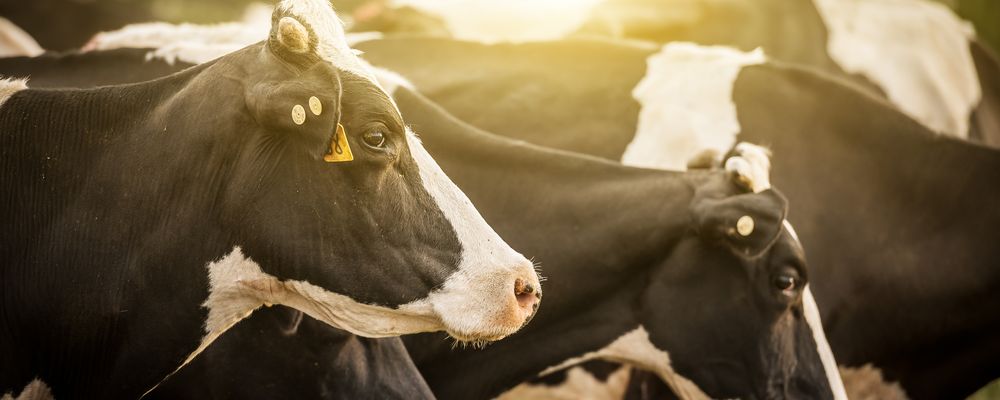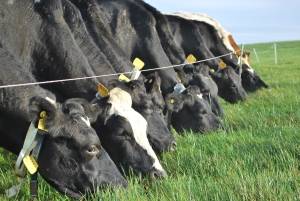Feeding our Planet range
With rising protein costs and concerns from processors about the environmental impact of protein sources, a focus on protein efficiency is becoming increasingly important
For many dairy farms, feeding TMR gives the flexibility to vary protein sources to both react to price volatility and demands of dairy processors to cut soya use. But what happens if you only feed grazed grass, grass silage and dairy compounds? Father and son Peter and Tim Goodman run a herd of 95 all year-round calving Holstein at Brockle Farm near Launceston in Cornwall. The 240-acre farm is predominantly down to grass. During the winter the milking herd is housed as one group and fed grass silage, both self-feed and out of ring feeders. High yielders get access to dairy compound in the parlour and through out of parlour feeders. Low yielders are fed in the parlour.
Cows are turned out by day from late March and are buffer fed silage until after first cut has been taken. As the farm is prone to drying out buffer feeding will be introduced during the summer as required, being started early to maintain grass covers. While at grass the main supplementary feeding is through the parlour. While the out of parlour feeders are sited close to the collecting yard, cows only have access for a limited time around milking. Cows are housed again in late October. The herd is averaging 9300 litres at 4.17% fat and 3.35% protein.
Planet Range
They have always fed a high-quality dairy feed as it is the only purchased feed used. Using a simple system with the compound providing the balance in the diet. They are usually averaging around 29 litres per cow per day. Arla looked to its dairy suppliers to reduce use of soya in dairy feeds, and they discussed the options with their nutritionist who recommended they change to Harpers Planet compounds.
The Massey Harpers Planet Range of feeds was the first in the UK formulated to help farmers move to net zero carbon, by eliminating the use of ingredients most closely linked to environmental damage. In the Planet range soya meal, soya hulls, soya oil and palm kernel have been replaced with proven alternatives with a lesser impact on the environment including protected rapeseed, sugar beet pulp and cereals. C16 has been replaced with a non-palm alternative.
The Planet range works extremely well and helped reduce the carbon footprint. When the cows at Brockle Farm are housed they will feed a maximum of 12kg/day through the parlour and out of parlour feeders. They use a higher protein specification as all cows have access to this. When the cows are turned out, they move to a lower protein Planet feed. Needing to maintain the UDP in the cake and make best use of the RDP in the grass to reduce overall protein costs, they monitor milk ureas closely as a guide to how well cows are using protein and will fine tune feed rates as required. To further improve efficiency of use of the protein in grass, the compound contains Novatan.
Protein
Grass protein is mainly in the form of rumen degradable protein (RDP) and there is often more than the rumen can utilise. If the rumen microbes are unable to use all the RDP, it will be broken down to ammonia in the rumen, absorbed into the blood stream and converted to urea leading to high levels of urea in the milk and blood. If the rumen cannot use the protein in grass, any excess protein is wasted and must be replaced with purchased protein if cows are to milk to their potential. In addition, there is an energy cost to the animal in excreting the excess protein as urea in the blood and milk, reducing the energy for milk production. Higher urea also results in poorer fertility due to the high pH and elevated NEFA concentrations in developing eggs.
Novatan
The specific blend of essential oils in Novatan inhibits the activity of hyper ammonia producing bacteria and improves the digestion of protein in the rumen. This increases protein capture in the rumen and reduces ammonia emissions and waste. Protein efficiency is improved and with grazing meeting more of the protein requirements, cows will need less protein in compounds and buffer feeds. The combination of increased grazing efficiency and more sustainable protein sources will become a core approach on dairy farms. Feeding compounds containing Novatan and non-soya protein sources to balance the protein in grazing will help improve performance at grass and improve margins while meeting the requirements on milk processors and help move towards net zero milk production.
More Information
Talk to your Feed Specialist about making our range of Planet feeds, or call the office on 01409 254 300. For all your dairy essentials, visit Harpers Farm Supplies







